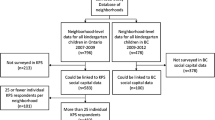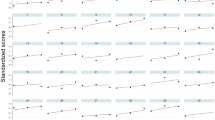In this investigation, we examine the impact of the ecological context of the residential neighborhood on the cognitive development of children by considering social processes not only at the family-level but also at the neighborhood-level. In a socioeconomically diverse sample of 200 African American children living in 39 neighborhoods in Baltimore, we found that neighborhood poverty was associated with poorer problem-solving skills over and above the influence of family economic resources and level of positive parent involvement. Sampson has theorized that neighborhood poverty affects child well-being by altering levels of neighborhood social capital as well as family social capital. Although we found that indicators of neighborhood and family social capital were associated with cognitive skills, these factors did not explain the association between neighborhood poverty and problem-solving ability. Implications for future research in the area of neighborhoods and child development are discussed.
Similar content being viewed by others
REFERENCES
Beckwith, L., & Parmelee, J. A. H. (1986). EEG patterns of preterm infants, home environment, and later IQ. Child Development, 57, 777–789.
Berg, M., & Medrich, E. A. (1980). Children in four neighborhoods: The physical environment and its effect on play and play patterns. Environment and Behavior, 12(3), 320–348.
Beyers, J. M., Bates, J. E., Pettit, G. S., & Dodge, K. A. (2003). Neighborhood structure, parenting processes, and the development of youths’ externalizing behaviors: A multilevel analysis. American Journal of Community Psychology, 31(1-2), 35–53.
Bradley, R. H., & Caldwell, B. M. (1980). The relation of home environment, cognitive competence, and IQ among males and females. Child Development, 51, 1140–1148.
Bradley, R. H., Caldwell, B. M., & Elardo, R. (1979). Home environment and cognitive development in the first 2 years: A cross-lagged panel analysis. Developmental Psychology, 15(9), 246–250.
Bradley, R. H., Caldwell, B. M., Rock, S. L., Barnard, K. E., Gray, C., Hammond, M. A., et al. (1989). Home environment and cognitive development in the first 3 years of life: A collaborative study involving six sites and three ethnic groups in North America. Developmental Psychology, 25(2), 217–235.
Brodsky, A. E. (1996). Resilient single mothers in risky neighborhoods: Negative psychological sense of community. Journal of Community Psychology, 24(4), 347–363.
Brody, G. H., Ge, X., Kim, S. Y., Murry, V. M., Simons, R. L., Gibbons, F. X., et al. (2003). Neighborhood disadvantage moderates associations of parenting and older sibling problem attitudes and behavior with conduct disorders in African American children. Journal of Consulting & Clinical Psychology, 71(2), 211–222.
Brooks-Gunn, J., Duncan, G. J., Klebanov, P. K., & Sealand, N. (1993). Do neighborhoods influence child and adolescent development? American Journal of Sociology, 99(2), 353–395.
Burton, L. M., & Price-Spratlen, T. (1999). Through the eyes of children: An ethnographic perspective on neighborhoods and child development. In A. S. Masten (Ed.), Cultural processes in child development. The Minnesota symposia on child psychology (Vol. 29, pp. 77–96). Mahwah, NJ, USA: Lawrence Erlbaum.
Caughy, M. O., O'Campo, P., & Brodsky, A. E. (1999). Neighborhoods, families, and children: Implications for policy and practice. Journal of Community Psychology, 27(615–633).
Caughy, M. O., O'Campo, P. J., Randolph, S. M., & Nickerson, K. (2002). The influence of racial socialization practices on the cognitive and behavioral competence of African American preschoolers. Child Development, 73(5), 1611–1625.
Caughy, M. O., Randolph, S. M., & O'Campo, P. J. (2002). The Africentric Home Environment Inventory: An observational measure of the racial socialization environment of the home for preschool children. Journal of Black Psychology, 28, 37–52.
Caughy, M. O. B., O'Campo, P. J., & Muntaner, C. (2004). Experiences of racism experiences among African American parents and the mental health of their preschool-aged children. American Journal of Public Health, 94(12), 2118–2224.
Chase-Lansdale, P. L., & Gordon, R. A. (1996). Economic hardship and the development of five- and six-year-olds: Neighborhood and regional perspectives. Child Development, 67(6), 3338–3367.
Chase-Lansdale, P. L., Gordon, R. A., Brooks-Gunn, J., & Klebanov, P. K. (1997). Neighborhood and family influences on the intellectual and behavioral competence of preschool and early school-age children. In J. Brooks-Gunn, G. J. Duncan, & J. L. Aber (Eds.), Neighborhood poverty: Context and consequences for children (Vol. 1, pp. 79–118). New York: Russell Sage Foundation.
Chavis, D., & Newbrough, J. (1985). The meaning of “community” in community psychology. Journal of Community Psychology, 14, 335–339.
Chavis, D. M., & Pretty, G. M. H. (1999). Sense of community: Advances in measurement and application. Journal of Community Psychology, 27, 635–643.
Chavis, D. M., & Wandersman, A. (1990). Sense of community in the urban environment: A catalyst for participation and community development. American Journal of Community Psychology, 14, 55–81.
Coleman, J. S. (1988). Families and schools. Educational Researcher, 16(6), 32–38.
Coleman, J. S. (1994). Social capital, human capital, and investment in youth. In A. C. Petersen (Ed.), Youth unemployment and society (pp. 34–50). New York: Cambridge University Press.
Coley, R. L., & Hoffman, L. W. (1996). Relations of parental supervision and monitoring to children's functioning in various contexts: Moderating effects of families and neighborhoods. Journal of Applied Developmental Psychology, 17, 51–68.
Collins, W. A., Maccoby, E. E., Steinberg, L., Hetherington, E. M., & Bornstein, M. H. (2000). Contemporary research on parenting. The case for nature and nurture. American Psychologist, 55(2), 218–232.
Coulton, C. J., Korbin, J. E., & Su, M. (1996). Measuring neighborhood context for young children in an urban area. American Journal of Community Psychology, 24(1), 5–33.
Davidson, W., & Cotter, P. (1991). The relationship between sense of community and subjective well-being: A first look. Journal of Community Psychology, 19, 246–253.
Demo, D. H., & Cox, M. J. (2000). Families with young children: A review of research in the 1990s. Journal of Marriage and the Family, 62(4), 876–895.
Duncan, G. J., & Raudenbush, S. W. (1999). Assessing the effects of context in studies of child and youth development. Educational Psychologist, 34(1), 29–41.
Duncan, G. J., & Rodgers, W. (1988). Longitudinal aspects of childhood poverty. Journal of Marriage and the Family, 50, 1007–1021.
Englund, M. (2001). A path analysis of the relationship between parental expectations, parental involvement, and children's achievement. Paper presented at the 2001 Biennial Meeting Society for Research in Child Development, Minneapolis, MN.
Estrada, P., Arsenio, W. F., Hess, R. D., & Holloway, S. D. (1987). Affective quality of the mother–child relationship: Longitudinal consequences for children's school-relevant cognitive functioning. Developmental Psychology, 23(2), 210–215.
Furstenberg, F. F. (1993). How families manage risk and opportunity in dangerous neighborhoods. In W. J. Wilson (Ed.), Sociology and the public agenda. (pp. 231–258). Newbury Park, CA: Sage.
Furstenberg, F. F., & Hughes, M. E. (1997). The influence of neighborhoods on children's development: A theoretical perspective and a research agenda. In J. Brooks-Gunn, G. J. Duncan, & J. L. Aber (Eds.), Neighborhood poverty: Policy implications in studying neighborhoods (Vol. II, pp. 23–47). New York: Russell Sage Foundation.
Garcia Coll, C., Lamberty, G., Jenkins, R., McAdoo, H. P., Crnic, K., Wasik, B. H., et al. (1996). An integrative model for the study of developmental competencies in minority children. Child Development, 67(5), 1891–1914.
Goldstein, H. (1995). Multilevel statistical models. New York: Halstead.
Goldstein, H., Rasbash, J., Browne, W., Woodhouse, G., & Poulain, M. (2000). Multilevel models in the study of dynamic household structures. European Journal of Population, 16(4), 373–387.
Jargowsky, P. A. (1997). Poverty and place: Ghettos, barrios and the American city. New York: Russell Sage Foundation.
Jencks, C., & Mayer, S. E. (1990). The social consequences of growing up in a poor neighborhood. In L. E. Lynn Jr. & M. G. H. McGeary (Eds.), Inner-city poverty in the United States (pp. 111–187). Washington, DC: National Academy Press.
Kaufman, A. S., & Applegate, B. (1988). Short forms of the K-ABC mental processing and achievement scales at ages 4 to 12 1/2 years for clinical and screening purposes. Journal of Clinical Child Psychology, 17(4), 359–369.
Klebanov, P. K., Brooks-Gunn, J., McCarton, C., & McCormick, M. C. (1998). The contribution of neighborhood and family income to developmental test scores over the first three years of life. Child Development, 69(5), 1420–1436.
Kohen, D. E., Brooks-Gunn, J., Leventhal, T., & Hertzmann, C. (2002). Neighborhood income and physical and social disorder in Canada: Associations with young children's competencies. Child Development, 73, 1844–1860.
Korbin, J., & Coulton, C. J. (1997). Understanding the neighborhood context for children and families: Combining epidemiological and ethnographic approaches. In J. Brooks-Gunn, G. J., & J. L. Aber (Eds.), Neighborhood poverty: Policy implications in studying neighborhoods (Vol. II, pp. 65–79). New York: Russell Sage Foundation.
Leventhal, T., & Brooks-Gunn, J. (2000). The neighborhoods they live in: The effects of neighborhood residence on child and adolescent outcomes. Psychological Bulletin, 126(2), 309–337.
Mariner, C. L., Zaslow, M. J., Floryan, J. A., & Botsko, C. (1998). Creating the Survey Measures of Mother–Child Relations for Middle Childhood (No. Methods Working Paper #98.9). Washington: Child Trends, Inc.
Massey, D., & Denton, N. (1993). American apartheid: Segregation and the making of the underclass. Cambridge: Harvard University Press.
McGroder, S. M. (2000). Parenting among low-income African American single mothers with preschool-age children: Patterns, predictors, and developmental correlates. Child Development, 71(3), 752–771.
McMillan, D., & Chavis, D. (1986). Sense of community: A definition and theory. American Journal of Community Psychology, 14, 6–23.
Minkler, M., & Wallerstein, N. (2003). Community-based participatory research for health. Berkeley, CA: Jossey Bass.
O'Brien, R. M. (1990). Estimating the reliability of aggregate-level variables based on individual-level characteristics. Sociological Methods and Research, 18(4), 473–504.
O'Campo, P. (2003). Advancing theory and methods for multilevel models of residential neighborhoods and health. American Journal of Epidemiology, 157(1), 9–14.
O'Campo, P., & Yonas, M. (2005). Health of economically deprived populations in cities. In Galea, S., & Vlahov, D. (Eds.) Handbook of Urban Health: Populations, Methods, and Practice (pp 43–62). New York: Springer.
Pretty, G. M. H., Andrewes, L., & Collett, C. (1994). Exploring adolescents sense of community and its relationship to loneliness. Journal of Community Psychology, 22, 346–358.
Raphael, D. (Ed.). (2004). Social determinants of health: Canadian perspectives. Toronto: Canadian Scholars Press Inc.
Rich, R. C., Edelstein, M., Hallman, W. K., & Wandersman, A. H. (1995). Citizen participation and empowerment: The case of local environmental hazards. American Journal of Community Psychology, 23(5), 657–676.
Sampson, R. J. (1992). Family management and child development: Insights from social disorganization theory. In J. McCord (Ed.), Facts, frameworks, and forecasts. Advances in criminological theory (Vol. 3, pp. 63–93). New Brunswick, NJ, USA: Transaction Publishers.
Sampson, R. J. (2001). How do communities undergird or undermine human development? Relevant contexts and social mechanisms. In A. Booth & A. C. Crouter (Eds.), Does it take a village: Community effects on children, adolescents, and families (pp. 3–30). Mahwah: Lawrence Erlbaum.
Sampson, R. J., Morenoff, J. D., & Earls, F. (1999). Beyond social capital: Spatial dynamics of collective efficacy for children. American Sociological Review, 64(5), 633–660.
Sampson, R. J., Raudenbush, S. W., & Earls, F. (1997). Neighborhoods and violent crime: A multilevel study of collective efficacy. Science, 277, 918–924.
Shaw, C., & McKay, H. (1942). Juvenile deliquency and urban areas. Chicago: University of Chicago Press.
Shumow, L., Vandell, D. L., & Posner, J. (1999). Risk and resilience in the urban neighborhood: Predictors of academic performance among low-income elementary school children. Merrill-Palmer Quarterly, 45(2), 309–331.
Simons, R. L., Lin, K.-H., Gordon, L. C., Brody, G. H., Murry, V., & Conger, R. D. (2002). Community differences in the association between parenting practices and child conduct problems. Journal of Marriage & the Family, 64(2), 331–345.
ACKNOWLEDGMENTS
This research was supported by grant #MCJ-240731-01-1 from the Maternal and Child Health Bureau. The authors would like to thank Deborah Brothers and Bennette Drummond-Fitzgerald for conducting interviews, and Kimberly Lohrfink for providing project management. Data management and analysis support was expertly provided by Yi Hua Chen, Crystal Evans, Patricia Gwayi-Chore, and Li Ching Lee. Finally, we would like to thank the families who so graciously welcomed us into their homes.
Author information
Authors and Affiliations
Corresponding author
Rights and permissions
About this article
Cite this article
Caughy, M.O., O'Campo, P.J. Neighborhood Poverty, Social Capital, and the Cognitive Development of African American Preschoolers. Am J Community Psychol 37, 141–154 (2006). https://doi.org/10.1007/s10464-005-9001-8
Published:
Issue Date:
DOI: https://doi.org/10.1007/s10464-005-9001-8




